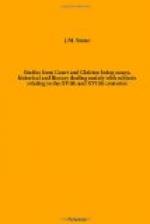“The Queen Mother told me that in speaking of certain miracles performed by the saint in whose honour the processions are being made just now at Antwerp, she observed the King listening attentively, seeming to have a decided taste for the Catholic religion. She however admitted, that although he appears to have great natural capacity, and to understand the critical state of his affairs, he is, as they say, timid, slow, and irresolute.”
Charles I. never went any further than the cultivation of “a decided taste for the Catholic religion,” and what would have happened had he really thrown himself into the arms of the Pope must remain one of those curious and unsolvable historical problems with which the world is full.
Would the Papacy, still a great force in Europe, have been able to save him from the terrible fate that awaited him?
Obliged to act from definite, logical principles in the place of his mischievous theory of the royal prerogative, would he have gained in moral weight as well as in the material advantages held out to him?
It may be answered that the Puritans were as little inclined to tolerate an infallible Pope whom they hated and feared, as an infallible king whom they could drive into a corner; and possibly the King would only have died in another cause.
Under a portrait of Charles I., painted in the fortieth year of his age, in which he is represented as grave, troubled, and with a scared and hunted look in his eyes, Prynne wrote these lines:—
“All flesh is grass, the best men vanity,
This, but a shadow, here before thine eye,
Of him whose wondrous changes clearly show
That God, not man, sways all things here below.”
PART II
I. THE RUNIC CROSSES OF NORTHUMBRIA
There is at the Victoria and Albert Museum at South Kensington a remarkable plaster cast, the facsimile of one of the two beautiful obelisks of Anglo-Saxon workmanship, which like far-reaching voices speak to us across the gulf of at least nine centuries.
The interest which surrounds these ancient crosses is of a twofold nature. There is the marvellous art expressed in the sculptured stones themselves, and there is the mysterious charm of the runes with which the stones are inscribed. The art is of a very high order, and in the opinion of archaeologists such as Haigh, Kemble, Professor Stephens, and others, better than anything of the kind produced in mediaeval times, before the beginning of the thirteenth century.




